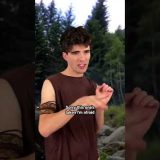True Facts: Reef Coral is a Crazy Animal!
Go to https://brilliant.org/zefrank to get a 30-day free trial + the first 200 people will get 20% off their annual subscription.
Donate: https://www.seawomen.net/donate-2/donations/
merch: https://ze-true-store.myshopify.com/
patreon: https://www.patreon.com/truefacts
classical music: https://soundcloud.com/querflote/5-au…
sponsor music: https://incompetech.com/
Thank you:
Daisy Buzzoni, University of Victoria
Dr Brett Lewis, Queensland University of Technology: https://www.youtube.com/@marinequt8941
Dr Todd LaJeunesse, Pennsylvania State University
Dr Jamie Craggs, Coral Spawning Lab: www.coralspawninglab.org
Dr Thibault Bouderlique, Medical University of Vienna
Peter Kragh: https://www.youtube.com/@2pkdk2
Tidal Gardens: https://www.youtube.com/@tidalgardens
Reefscapers.com: https://www.youtube.com/@Reefscapers
ReefBros: https://www.youtube.com/@ReefBrosOfficial
TIB
Ken Marks
Narrissa Spies
Citations
Carbonne, C., Comeau, S., Chan, P. T. W., Plichon, K., Gattuso, J.-P., and Teixidó, N.: Early life stages of a Mediterranean coral are vulnerable to ocean warming and acidification, Biogeosciences, 19, 4767–4777, https://doi.org/10.5194/bg-19-4767-2022, 2022.
Gavelis GS, Wakeman KC, Tillmann U, Ripken C, Mitarai S, Herranz M, Özbek S, Holstein T, Keeling PJ, Leander BS. Microbial arms race: Ballistic “nematocysts” in dinoflagellates represent a new extreme in organelle complexity. Sci Adv. 2017 Mar 31;3(3):e1602552. doi: 10.1126/sciadv.1602552.
Kawamura, Kaz, Sekida Satoko, Nishitsuji Koki, Shoguchi Eiichi, Hisata Kanako, Fujiwara Shigeki, Satoh Noriyuki. In vitro Symbiosis of Reef-Building Coral Cells With Photosynthetic Dinoflagellates, Frontiers in Marine Science, Vol 8,2021, DOI: 10.3389/fmars.2021.706308
Laissue, P.P., Roberson, L., Gu, Y. et al. Long-term imaging of the photosensitive, reef-building coral Acropora muricata using light-sheet illumination. Sci Rep 10, 10369 (2020). https://doi.org/10.1038/s41598-020-67144-w
Lewis, B.M., Suggett, D.S., Prentis, P.J. et al. Cellular adaptations leading to coral fragment attachment on artificial substrates in Acropora millepora (Am-CAM). Sci Rep 12, 18431 (2022). https://doi.org/10.1038/s41598-022-23134-8
Mullen AD, Treibitz T, Roberts PLD, Kelly ELA, Horwitz R, Smith JE, Jaffe JS. Underwater microscopy for in situ studies of benthic ecosystems. Nat Commun. 2016 Jul 12;7:12093. doi: 10.1038/ncomms12093.
Musco L, Vega Fernández T, Caroselli E, Roberts JM, Badalamenti F. Protocooperation among small polyps allows the coral Astroides calycularis to prey on large jellyfish. Ecology. 2018 Oct;99(10):2400-2401. doi: 10.1002/ecy.2413.
Neder M, Laissue PP, Akiva A, Akkaynak D, Albéric M, Spaeker O, Politi Y, Pinkas I, Mass T. Mineral formation in the primary polyps of pocilloporoid corals. Acta Biomater. 2019 Sep 15;96:631-645. doi: 10.1016/j.actbio.2019.07.016.
Poon, Rebecca N., Timothy A. Westwood, Hannah Laeverenz-Schlogelhofer, Emelie Brodrick, Jamie Craggs, Eric E. Keaveny, Gáspár Jékely, Kirsty Y. Wan. Ciliary propulsion and metachronal coordination in reef coral larvae. bioRxiv 2022.09.19.508546; doi: https://doi.org/10.1101/2022.09.19.508546
Scucchia F, Sauer K, Zaslansky P, Mass T. Artificial Intelligence as a Tool to Study the 3D Skeletal Architecture in Newly Settled Coral Recruits: Insights into the Effects of Ocean Acidification on Coral Biomineralization. Journal of Marine Science and Engineering. 2022; 10(3):391. https://doi.org/10.3390/jmse10030391
Shapiro OH, Fernandez VI, Garren M, Guasto JS, Debaillon-Vesque FP, Kramarsky-Winter E, Vardi A, Stocker R. Vortical ciliary flows actively enhance mass transport in reef corals. Proc Natl Acad Sci U S A. 2014 Sep 16;111(37):13391-6. doi: 10.1073/pnas.1323094111.








Head over to https://brilliant.org/zefrank to get a 30-day free trial + the first 200 people will get 20% off their annual subscription!
Things get dirty :=))))
True facts about pinnipeds?? Seals and sea lions?
Thank you for this.
What is your background music for your True Facts videos?
#Seconded
Coral is such an interesting animal. Many individuals sharing a single calcium carbonate skeleton, forming an entire ecosystem out of it, and getting nutrients through photosynthesis via algea in their cells. There’s just something so amazing about it all.
Reminds me of eusociality in insects, but… more plant-like. Crazy stuff…
Nature is so wild and beautiful.
Now imagine an entire Alien Species that’s like that…
I grow corals and agree with you, but some corals do not use photosynthesis to get their nutrients. Many types of fan corals are like that along with the sun coral. I stay away from them as they are very difficult to keep alive because of their nutrient requirements. You have to feed them about 4 times a day or more. Putting that many nutrients in your tank can cause your tank to crash. They are not worth the trouble for me. SPS corals are difficult to grow because they are very unforgiving if your parameters are not perfect. The only corals that do not require feeding on a regular basis are softies
its a bit horrifying
As a company that grows coral to restore dying reefs, we can confirm that this video, ZeFrank, and corals rock 🪸
Animals with plants inside them that make rock for their skeleton
Nice! Thank you for the good that you do.
thank you for your contribution. but how exactly does one turn a profit doing that, might I ask?
The great barrier reef is better than ever despite global warming
@Rockribbed1 Nah… props to Jim Jeffries, but it’s more of the Good Barrier Reef these days at best
Ze always makes the most quotable videos! “fart crystals” “fish-flavored Tic Tacs…” So much awesomeness here!
lung biscuit!
“wig of a drowning clown”
“Albino raspberry and a sneeze”
“quivering loogie”
I want a “fart crystals” tshirt
Wow! Incredibly good coverage of these amazing animals! I have raised them for years, and you hit pretty much everything any hobbiest would need to understand, as well as making it entertaining, succinct, and accurate. 10/10
ZeFrank does it best!!
You raise quivering loogies?
You gotta mix in some fungi and slime molds to make a truly alien looking ecosystem. Granted they are all from earth but together they all seem very unique
Did they bud off you, or did you pinch in half?
What’s even cazier about animals like coral, jellyfish, and sponges is the fact that they’ve been pretty much around since the dawn of time
Dawn of multicellular life maybe?
Dawn of time: 13787 myo
Earth forms: 4540 myo
Life: 3800 myo
Coral: 535 myo
Best way to start the day is with a Ze Frank video.
And to finish, too! (from Korea)
I am ending my day with a ze Frank video. It’s a bit early but today was long day.
True
Ok, but-
Have you ever had sex with a shy femboy neko who, allthough he is usualy very nervous and scared with people, feels totaly safe in your arms, giving you his entire heart and body out of deepfelt love and trust?
Imagine if Jerry was able to get that old buzzard Creepy Dave on this show. He’d be producer of the year!
That would be awesome 😎
I like them separate
Creepy Davis is a vulture >:(
@Excusablehoneybee, Buzzard = vulture.
I prefer the long content like this. Can only take so much of Creepy Dave at any given point in time. 😀
You know, even though I was taught that Coral was an Animal very early on (Thank you Jumpstart 3rd Grade), I never ever questioned, even till now, how they reproduce after learning that fact.
Usually, I’m afraid of corals (basically all cnidarians and most of sea invertebrates) but this video wasn’t as scary. At some point, you just get used to the fact that we have eldritch horrors living just under the surface of the water. They’re colorful and pretty!
Eldritch has a tendency to describe a good 20% of sea life coral is probably the least Eldritch thing in there ( besides the whole carpet with multiple mouths thing)
@someone u dont know, True. The stinging ferny, ferny hydroids and certain crabs, fireworms, and seahorses come to mind.
@Suzi Q don’t forget 90% of anything lower than 4000 metres below sea level, especially the eals.
Seriously, there are 3 levels to the midnight zone, and one of them is literally called the abyssal zone, and I’m pretty sure hp lovecraft just asked God if he could copy his homework from there
@someoneudontknow3709 I think a flesh carpet of mouths, tentacles, and intestines, sitting on top of skeletons, is pretty eldritch.
Of all the things in the sea that are legitimately terrifying, you’re afraid of coral? Other cnidarians like starfish and urchins I can understand. But I guess under a microscope, those little polyps are pretty freaky. Like something out of pre 2000 horror film.